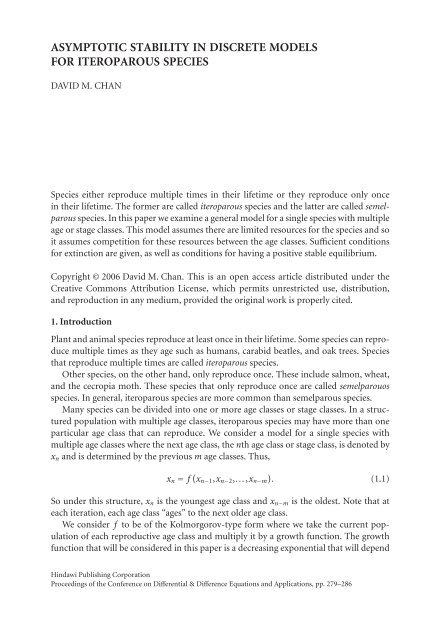DIFFERENtIAl & DIFFERENCE EqUAtIONS ANd APPlICAtIONS
DIFFERENtIAl & DIFFERENCE EqUAtIONS ANd APPlICAtIONS
DIFFERENtIAl & DIFFERENCE EqUAtIONS ANd APPlICAtIONS
You also want an ePaper? Increase the reach of your titles
YUMPU automatically turns print PDFs into web optimized ePapers that Google loves.
ASYMPTOTIC STABILITY IN DISCRETE MODELS<br />
FOR ITEROPAROUS SPECIES<br />
DAVID M. CHAN<br />
Species either reproduce multiple times in their lifetime or they reproduce only once<br />
in their lifetime. The former are called iteroparous species and the latter are called semelparous<br />
species. In this paper we examine a general model for a single species with multiple<br />
age or stage classes. This model assumes there are limited resources for the species and so<br />
it assumes competition for these resources between the age classes. Sufficient conditions<br />
for extinction are given, as well as conditions for having a positive stable equilibrium.<br />
Copyright © 2006 David M. Chan. This is an open access article distributed under the<br />
Creative Commons Attribution License, which permits unrestricted use, distribution,<br />
and reproduction in any medium, provided the original work is properly cited.<br />
1. Introduction<br />
Plant and animal species reproduce at least once in their lifetime. Some species can reproduce<br />
multiple times as they age such as humans, carabid beatles, and oak trees. Species<br />
that reproduce multiple times are called iteroparous species.<br />
Other species, on the other hand, only reproduce once. These include salmon, wheat,<br />
and the cecropia moth. These species that only reproduce once are called semelparouos<br />
species. In general, iteroparous species are more common than semelparous species.<br />
Many species can be divided into one or more age classes or stage classes. In a structured<br />
population with multiple age classes, iteroparous species may have more than one<br />
particular age class that can reproduce. We consider a model for a single species with<br />
multiple age classes where the next age class, the nth age class or stage class, is denoted by<br />
x n and is determined by the previous m age classes. Thus,<br />
x n = f ( x n−1 ,x n−2 ,...,x n−m<br />
) . (1.1)<br />
So under this structure, x n is the youngest age class and x n−m is the oldest. Note that at<br />
each iteration, each age class “ages” to the next older age class.<br />
We consider f to be of the Kolmorgorov-type form where we take the current population<br />
of each reproductive age class and multiply it by a growth function. The growth<br />
function that will be considered in this paper is a decreasing exponential that will depend<br />
Hindawi Publishing Corporation<br />
Proceedings of the Conference on Differential & Difference Equations and Applications, pp. 279–286

















